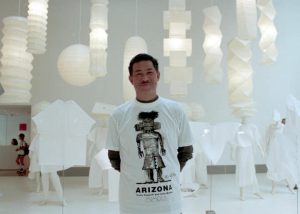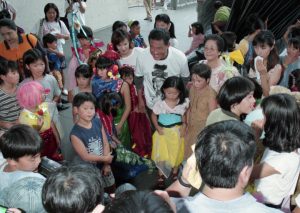Remembering Issey Miyake: his distance from Hiroshima and mixed feelings
Aug. 13, 2022
by Izumiko Soda
When asked about his starting point, Issey Miyake mentioned the newly-built Peace Bridge. He said, “When I went to a painting class on the Hondori shopping street or to Hiroshima Peace Memorial Park with a bread roll, I was strongly aware that this was the design.” This was when he attended Hiroshima Kokutaiji High School located in the city’s Naka Ward.
The railings of the Peace Bridge were designed by Isamu Noguchi. Mr. Miyake later interacted deeply with Mr. Noguchi, who opened the door to his design career. In 1997, an exhibition with the theme of the two was held in the city of Marugame, Kagawa Prefecture, and I interviewed Issey at the venue.
Mr. Noguchi, who had a Japanese father and an American mother, ended up as a “global citizen” in his search for identity. Issey said, “After graduating from college, I went to Paris, too, and when I thought about the West, the East, and the essence of being a Japanese, Isamu’s way of living helped me. So, Isamu is a master in my mind.”
When Issey was a senior high school student, Hiroshima was in the process of reconstruction and was much more rural than it is now. Media would have been limited and information scarce. He seemed to have been fighting hard to open up the future.
I heard this episode from a classmate of his. Issey asked him to go to the Hiroshima Municipal Auditorium with him as Junichi Nakahara, who was very popular for his cover illustration of the women’s magazine “Soleil,” was coming. He said, “Issey was sitting in the front among all the women. Unlike me, he didn’t seem embarrassed.” Issey corresponded with Chiyo Uno, who was a successful writer and kimono designer. I was surprised by his ability to take action as he generally admitted to being shy.
At the time of the interview, he did not actively talk about his experience of the atomic bombing. He said that journalists from overseas wanted to associate his work with the A-bombing, which he felt was frustrating. “I don’t speak for Hiroshima. I’ve made efforts that go beyond the framework of Hiroshima,” he spoke about his pride.
On the other hand, Issey was well aware of Hiroshima’s desire for peace. He also said, “I think that town has been revived and has become not just a town of tragedy but a town full of hope.” He called his hometown “that town.” The expression “that town” made me flinch, as if I had been confronted with his distance from his hometown and mixed feelings.
For that reason, it was surprising that in 2009 he wrote a letter to then U.S. President Barack Obama urging him to visit Hiroshima and elaborated on his A-bombing experience in the Yomiuri Shimbun in 2015. Was I immature as an interviewer or has he gotten older? With the constant conflicts in the world and the nuclear accident in Fukushima, did he feel compelled to do something?
His best-selling clothes, Pleats Please, create a gentle silhouette in its own way even if worn by a pregnant woman or a skinny person. They can be folded to a compact size and are wrinkle-proof. They are machine washable and dry quickly. That is the true value of Issey, who said, “I want to create universal clothes like jeans and T-shirts.”
Pleats Please is not all about functionality. He pursued the threads, weave, and dye he envisioned. He also said, “If I use foreign fabrics for my clothes, the originality is halved.” Combining traditional Japanese materials, craftsmanship, and the latest technology, he achieved individuality and functionality.
Issey Miyake’s clothes last long. I have his clothes that I bought 30 years ago. There are also suits and coats that can be washed. Issey Miyake’s directly managed store withdrew from Hiroshima at the beginning of last year. It was part of the reorganization of local stores. And now, we have lost Issey.
Issey Miyake passed away on August 5 at the age of 84.
(Originally published on August 13, 2022)
When asked about his starting point, Issey Miyake mentioned the newly-built Peace Bridge. He said, “When I went to a painting class on the Hondori shopping street or to Hiroshima Peace Memorial Park with a bread roll, I was strongly aware that this was the design.” This was when he attended Hiroshima Kokutaiji High School located in the city’s Naka Ward.
The railings of the Peace Bridge were designed by Isamu Noguchi. Mr. Miyake later interacted deeply with Mr. Noguchi, who opened the door to his design career. In 1997, an exhibition with the theme of the two was held in the city of Marugame, Kagawa Prefecture, and I interviewed Issey at the venue.
Mr. Noguchi, who had a Japanese father and an American mother, ended up as a “global citizen” in his search for identity. Issey said, “After graduating from college, I went to Paris, too, and when I thought about the West, the East, and the essence of being a Japanese, Isamu’s way of living helped me. So, Isamu is a master in my mind.”
When Issey was a senior high school student, Hiroshima was in the process of reconstruction and was much more rural than it is now. Media would have been limited and information scarce. He seemed to have been fighting hard to open up the future.
I heard this episode from a classmate of his. Issey asked him to go to the Hiroshima Municipal Auditorium with him as Junichi Nakahara, who was very popular for his cover illustration of the women’s magazine “Soleil,” was coming. He said, “Issey was sitting in the front among all the women. Unlike me, he didn’t seem embarrassed.” Issey corresponded with Chiyo Uno, who was a successful writer and kimono designer. I was surprised by his ability to take action as he generally admitted to being shy.
At the time of the interview, he did not actively talk about his experience of the atomic bombing. He said that journalists from overseas wanted to associate his work with the A-bombing, which he felt was frustrating. “I don’t speak for Hiroshima. I’ve made efforts that go beyond the framework of Hiroshima,” he spoke about his pride.
On the other hand, Issey was well aware of Hiroshima’s desire for peace. He also said, “I think that town has been revived and has become not just a town of tragedy but a town full of hope.” He called his hometown “that town.” The expression “that town” made me flinch, as if I had been confronted with his distance from his hometown and mixed feelings.
For that reason, it was surprising that in 2009 he wrote a letter to then U.S. President Barack Obama urging him to visit Hiroshima and elaborated on his A-bombing experience in the Yomiuri Shimbun in 2015. Was I immature as an interviewer or has he gotten older? With the constant conflicts in the world and the nuclear accident in Fukushima, did he feel compelled to do something?
His best-selling clothes, Pleats Please, create a gentle silhouette in its own way even if worn by a pregnant woman or a skinny person. They can be folded to a compact size and are wrinkle-proof. They are machine washable and dry quickly. That is the true value of Issey, who said, “I want to create universal clothes like jeans and T-shirts.”
Pleats Please is not all about functionality. He pursued the threads, weave, and dye he envisioned. He also said, “If I use foreign fabrics for my clothes, the originality is halved.” Combining traditional Japanese materials, craftsmanship, and the latest technology, he achieved individuality and functionality.
Issey Miyake’s clothes last long. I have his clothes that I bought 30 years ago. There are also suits and coats that can be washed. Issey Miyake’s directly managed store withdrew from Hiroshima at the beginning of last year. It was part of the reorganization of local stores. And now, we have lost Issey.
Issey Miyake passed away on August 5 at the age of 84.
(Originally published on August 13, 2022)









